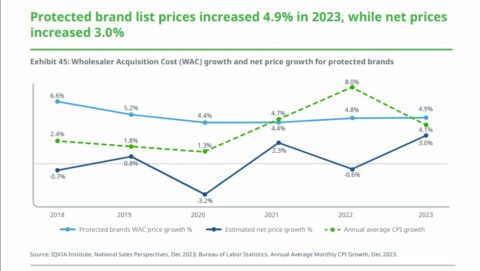I’m usually loathe to link to articles that are behind particularly high paywalls, but I’m going to make an exception. If you subscribe to BioCentury, check out this piece on the impact of Arnold Ventures on the IRA. (If you don’t, you can check out the BioCentury podcast for an overview.)
It’s a great overview of what John Arnold is spending his money on, and how the group thinks about its mission. It’s not necessarily a revelation, but everything is laid out clearly. The story leaves no question about where Arnold has come from or where he’s going.
It also describes the Arnold “playbook”:
Arnold Ventures has catalyzed change by producing evidence that policymakers, the press, and the public find credible. It has synthesized that evidence into proposals, formulated clear messages to explain those proposals, and strategically deployed donations and advertising to support politicians who will enact them.
For what it’s worth, I tried to define the Arnold playbook last month (and got some static from grantees) but I think BioCentury vet Steve Usdin captures it better.
In my newsletter from last month, I also suggested that patent reform looked like the next place where that playbook was going to be used, and — indeed — Usdin confirms that IP is the next great Arnold battleground:
One way to improve competition, Arnold Ventures believes, is for Congress to address IP practices that it considers anticompetitive, including patent thickets, product hopping, abuse of the citizen petition process, and using REMS to prevent biosimilar and generic drug developers from gaining access to samples needed to develop competing products.
And how is that effort going? Pretty well, if you believe Axios.
The one other piece that caught my eye were some quotes from Arnold’s drug-pricing majordomo, Mark Miller, especially this one: “I’m unconvinced by the evidence that I’m seeing that the drug industry is citing that net prices are falling.”
That’s fascinating because falling net prices seem to be one part of the conversation that’s been settled. We can argue about the impact of launch prices or IP or the role of government, but the fact that third parties, pharma companies, and PBMs are all coming to the same conclusion on net prices feels like a pretty good sign that this is a real phenomenon. But not if you’re Arnold Ventures, I guess.
(This is my opportunity to re-flag last week’s news from STAT that found that Arnold is getting less transparent, even as they grow in influence. Irony!)
Last month, the Congressional Budget Office sent an open call for research and perspective on how it should model the impact of policy changes on the development of new medicines. This is an area where there’s not a lot of consensus: the CBO has consistently concluded that the impact of regulation will be minimal while other models have suggested a larger (if not catastrophic) impact.
So that makes this extensive response from No Patient Left Behind worth the read. The group over there created an extensive and readable overview of how R&D funding decisions get made by investors and what the impact of the IRA is likely to be in the real world, informed by perspectives from real investors.
It’s worth checking the bottom, too, where investors and analysts have signed on. If you’ve been in the innovation space for any length of time, you’re likely to see several names there that you recognize. And if you want to sign on, here’s the form.
A quick reminder: Arnold isn’t just going after drugmakers. They have other targets, too, including hospitals. That makes this Endpoints piece — about Arnold-funded research — an extra-interesting read. It looked at the price of hospital-administered meds and found that between 2009 and 2018, list prices rose about 4.4% a year. Yet the patient out-of-pocket burden was up 9.6%. And the researchers found that there was no connection between the two numbers, concluding that it’s a vestige of hospital markups. I hate to over-index on finger-pointing here (believe it or not), but this is a case where there really is one, central villain.
I’m loathe to give the Wall Street Journal editorial board too much credit (or too much attention), but they wrote a whole editorial about how Bernie Sanders’ drive to force pharma CEOs — especially those suing over the IRA — to appear before his committee is just a “show trial.” Which is exactly right.
One of my most firmly held beliefs is that, in 2024, on average, no one pays attention to anything, other than maybe Taylor Swift and Travis Kelce. It’s a huge challenge for those trying to inform or sway the public on any subject. And it’s why I’m hugely skeptical of this STAT article that suggests that pharma’s legal attack on the IRA is going to help Joe Biden politically by raising awareness of the IRA. My impression is that no one is tracking on the lawsuits, no one is tracking on IRA implementation, and most people don’t have the background to understand what’s going on even if they are exposed to those topics. (I’m in a dark place when it comes to the civic engagement of Americans.)
Oh, this is going to be a paper worth clipping and saving: ICER’s new Chief Scientific Officer Dan Ollendorf has a journal piece out arguing for a centralized American HTA: “To meet the needs of US stakeholders, a homegrown HTA approach could include CEA along with budget impact and other forms of economic analysis, allow strong stakeholder partnerships, and serve as a testbed for novel approaches to value assessment. In addition, given that prices are universally high in America not only for prescription drugs but also for many other health technologies and services, the remit for a US-based HTA body should be quite broad.”
Here’s a paper by serious folks on the cost-effectiveness of gene therapy for sickle cell disease. The upshot is that these technologies are cost-effective up to about $2.5 million, depending on the perspective. It’s tempting but probably not fair to compare that number to the list price of the Vertex and bluebird therapies, where net prices will be lower — maybe far lower — due to mandated discounts and outcomes-based agreements.
If this email was forwarded to you, and you’d like to become a reader, click here to see back issues of Cost Curve and subscribe to the newsletter.





